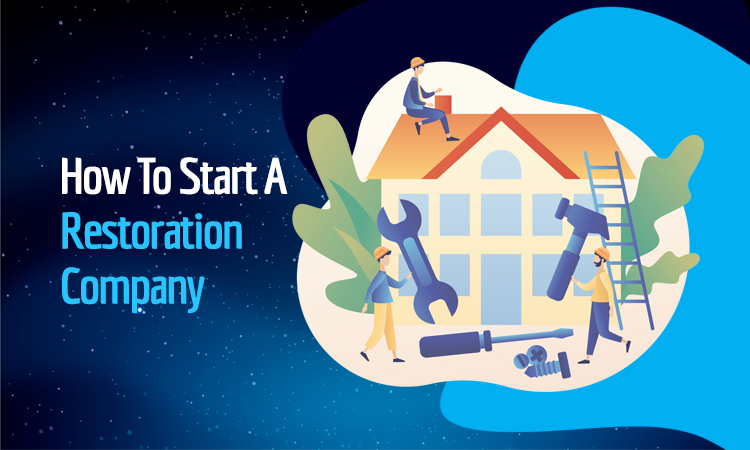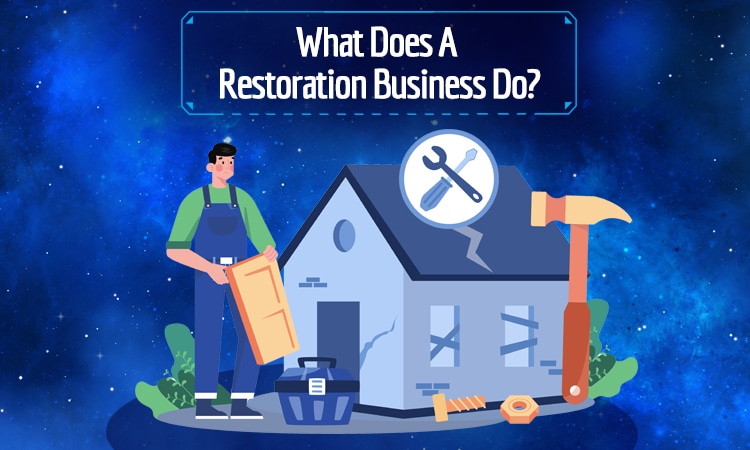



Hello! My name is Travis, and I built a million-dollar restoration company in 12 months by leveraging digital marketing. I have been in the SEO industry since 2012 and have helped hundreds of companies create explosive growth.
In this guide, we walk through the basic steps of starting your restoration business and share some resources to help you successfully market your services.
As long as there is wind, water, and fire, there will be demand for a restoration business. Mitigation services are essential for properties damaged by flooding, fires, or storms.
Whether you work with residential or commercial customers – or even both – a water restoration business can be incredibly profitable.
The industry has seen positive explosive growth in the last few years. The remediation industry is worth $41.2 billion, but it’s expected to rise to over $80 billion in the next decade.
Part of the reason this is such a profitable business is the billing structure. You can put out a certain number of air movers, conventional dehumidifiers, and other equipment like negative air machines or air scrubbers on each job.
Each day, you can bill the insurance company or property owner for every piece of equipment you have on-site. This means that you can scale your income using equipment vs. relying solely on the billable labor hours of your staff.
A water damage restoration business is worth considering between the growing demand and the profitability.
Today, we’ll discuss the steps involved in starting a water restoration business, which provides invaluable support to those suffering from water damage or mold infestations.
Before you know it, you’ll be a certified water restoration expert who can assist homeowners and business owners in your area in getting back on their feet.
The starting cost can range significantly depending on the scale of your operations and the types of services you offer. Initial investments in equipment and materials typically range from $25,000 to $175,000. However, you should also consider additional costs such as:
It’s also advisable to forecast working capital and maintain an emergency fund. The total cost can vary greatly, but an average range could be from $30,000 to $200,000.

Water damage restoration companies work to bring a property back to its former glory with drying equipment, mold remediation, and restoration services. Some of the specialties that may be present in a water restoration business include mold removal specialists, roofers, general contractors, and even carpenters or upholstery experts.
While similar, residential and commercial water damage has different challenges and considerations. For example, a residential restoration business will spend more of its time working with more delicate items with high sentimental value; it may want to have fabric experts and carpenters on their team. On the commercial side, the main challenges include operationalizing the business quickly and dealing with larger square footage, which often comes with more complicated wiring and systems.
There are three basic types of damage restoration: fire, mold, and water. Many companies work with all three, while some focus on only one or two.
Fire damage remediation often goes hand in hand with water damage: firefighters will use enormous amounts of water to put out large fires, and commercial sprinkler systems will douse the entire structure too. This can lead to mold if not taken care of immediately, so it’s a good idea to be at least familiar with the techniques involved in mold remediation, even if you plan to refer that part to other restoration companies.
Each of these comes with its challenges, particularly when repairing structural damage. Eradicating mold requires knowing how to handle this substance carefully, what materials cannot be cleaned, and what disinfectants will clear fungus. To fix fire damage, you must be familiar with how smoke and soot penetrate materials and how to remove them; lastly, for water damage, you’ll need to know what building materials are compromised by water and what will need to be entirely replaced.
As a restoration business owner, you must consider what your local market looks like, what other competing businesses in your area do and do not provide, and who your target market is. This goes back to whether you will handle commercial and/or residential restoration.
When conducting market research, there are a few things you’ll need to consider as you gather your information:
Other considerations include how broad a service area you should have based on what other companies are doing, what types of restoration projects should cost relative to square footage and time, and how you will negotiate with insurance companies. Along the way, be honest about why you are starting a restoration business and plan your actions accordingly.
After you’ve completed your market research, it’s time to decide exactly what services you will provide. As mentioned, there are three major types of damage remediation, so you must decide whether to handle all of these or focus all your attention on one.
Customers want comprehensive solutions; in other words, they want someone to clean up the damage and restore their property. Many also want to tackle renovations simultaneously: if you can provide this for them, your restoration business will be incredibly popular.
You may also consider providing additional services within your expertise, including consulting to determine a property’s risk of fire or water damage or conducting preventative maintenance like sealing basements and disinfecting areas at high risk of mold damage.

Before starting a restoration career, you need to develop a business plan. A well-structured plan will become a guiding document that helps you make good decisions and keeps you on track.
Your business plan should include these key components:
If you’re struggling with building a business plan, many excellent resources from business schools nationwide exist. Even one course in business administration can be incredibly useful. You might also find it helpful to find a good business mentor who can help guide you through these initial steps to starting your own restoration business.
To help your customers, you should meet industry certification standards, even if they are not required in your area. The Institute of Inspection Cleaning and Restoration Certification is the primary certifying body for the restoration industry; IICRC-certified professionals are highly sought after, and many insurance agents will not work with any company that is not certified.
To get IICRC certification, you must undergo water restoration training from an approved school, then pass the exams. Getting an IICRC certification as an individual is not the same as becoming an IICRC-certified business.
You should also consider OSHA training to help you conduct your work safely.
Not every state requires licensing; for those that do, their requirements vary. To ensure you’re not violating state or national regulations, check with official state government sites, which should have all the information you need regarding licensing and registration.
Lastly, you must be insured and bonded, as otherwise, you may run into legal issues should there be a problem with a restoration project. You’ll want to find an insurance company that has worked with other restoration businesses and knows the specific hazards of your type of work.

Now that you’re protected against liabilities, and you’ve received your own IICRC training, it’s time to find great professionals who can assist you in your work. While every team will have a slightly different lineup, you need professionals who can tackle any job within your area.
Before you start writing job descriptions, you need to consider the key roles that need to be filled. There are the administrative, restoration, and renovation sides (if that applies). This is just a short list of positions you will likely have available:
When hiring staff, you should look at job descriptions from other companies to see how to phrase your needs properly. You should expect to provide training for entry-level roles and build this into your considerations when hiring new people. You’re best off getting a small but dedicated crew, knowing you can hire additional employees as more jobs roll in.
A strong restoration business has a great culture built on mutual respect, consistent feedback, and a good work-life balance. If you want the best from your employees, you need to give your best, too!
Even IICRC-certified professionals can’t do their work without the right equipment. You should expect to invest heavily in the proper tools when you first set up shop; do your best to select high-quality, reliable equipment rather than going for the cheapest possible price.
Some of the basic equipment you should buy right away includes:
At the very least, you should purchase a dehumidifier and a few air movers. This will allow you to effectively pull moisture from the air and create airflow to speed up the drying process.
As your new business grows, you should slowly acquire more good equipment until you have enough to cover as many job sites as you feel your team can handle at a given time.
When you’re ready to invest in new products, consider checking out the IICRC website to learn about the recent advancements in restoration technology. Another excellent resource for remediation industry-specific services is Remediation and Restoration Magazine, which details the newest technology for water restoration and mildew eradication.
A marketing plan is an essential component of any business. You must stand out and have a unique brand identity to get job referrals.
There are many ways to generate leads for your water restoration business, including pay-per-click advertising and more traditional print advertising. However, one of the best ways to advertise is by focusing on search engine optimization, which drives organic traffic to your site.
Our helpful guides can assist you in getting started, and you can also contact us to learn more about our Restoration Company SEO Services.
Developing great relationships with other industry professionals is another essential component of marketing and success as a business owner. You should reach out to local claims adjusters and introduce yourself. Take special care to contact local property managers so that you’re first and foremost in their minds when it’s time to pick a restoration business.
Like with any other industry, customer service is key. Satisfied clients can be the difference between having plentiful jobs and finding your water restoration company going underwater.
Start on the right foot with potential clients by showing empathy and clear concern for their circumstances; nothing is more important to an anxious homeowner or business owner than knowing someone is on their side. This can make explaining difficult circumstances during a tough restoration easier and still get good referrals.
Every great customer interaction will develop your reputation, so focus on the customer in front of you and give them your best.

Every business requires good financial management. No matter how small your team is, you should consider hiring an accountant or partnering with an outside agency to ensure you meet your tax obligations. An accountant can also advise you on how to manage your cash flow so that you can weather slow seasons: Summer and winter tend to be quite hectic in many regions, but they vary by area.
When it comes to pricing, try to stay in the midline of your competitors rather than severely undercutting them, as this can make potential customers leery and requires you to skimp on your expenses. Don’t be afraid to spend money on good equipment and staff training; many great business leaders have floundered because they were scared of spending money.
Lastly, build scalability into your business so that you’re not struggling from growing pains when these opportunities arrive. Do you want to franchise, or will you manage new offices yourself? You should consider these considerations before they become a possibility so that you’re ready to seize the opportunity when it arrives.
Owning your own business is incredibly rewarding, as it allows you to help other people get their life back on track.
You can build a powerful and profitable company that lasts decades with restoration industry research, good investments, and a great team.
Franchise and independent businesses each have their unique advantages and disadvantages.
Franchises offer a proven business model and ongoing support, which can reduce some of the risks associated with starting a new business.
They have strong brand recognition, unique marketing strategies, and established business operations.
They provide training to ensure the franchisee understands how to run the business efficiently.
Franchises can be costly, requiring initial investment and ongoing fees such as royalties and advertising costs.
There may be less autonomy in business decisions due to adherence to the franchise’s business model and standards.
Independent businesses provide greater autonomy in business decisions, allowing for creativity and flexibility.
They may have lower initial costs as they don’t require franchise fees.
They may involve higher risks as everything from branding to business models must be developed from scratch.
They lack the support of an established brand, which might result in spending more on marketing and branding efforts.
Sources:
Travis Bliffen is the founder of Stellar SEO. His background as a U.S. Army combat veteran and a dedicated business owner has shaped his approach to SEO, blending discipline, thorough research, business acumen, and a deep understanding of the evolving SEO landscape.
Travis Bliffen's expertise and contributions in the field of SEO have earned him recognition and features in several prominent publications, such as Search Engine Journal and SEMrush, where he has shared his insights and strategies for effective SEO practices. Since launching Stellar SEO in 2012, he has been committed to crafting tailored link-building and SEO campaigns for clients across diverse niches.